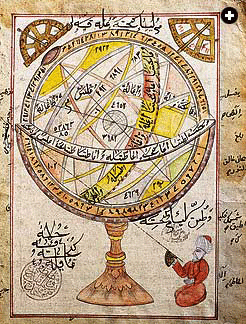
[Illustration: An astronomer calculates the position of a star with an armillary sphere and a quadrant in this illustration from a 16th-century Ottoman manuscript, ART ARCHIVE /UNIVERSITY LIBRARY ISTANBUL /DAGLI ORTI]
[Note: The current issue of “ARAMCO World” has a long and well illustrated article on the history of the sciences in the islamic World. This is written by Richard Covington, an author based in Paris.]
Like astronomy, which evolved from the practical necessities of finding the directions and hours for prayers, Islamic mathematics was very much a hands-on affair at the beginning, a product of the marketplace and of the need for pragmatic legal precedents. Both algebra and the use of zero had the same end in mind—streamlining computations for business deals. Al-Khwarizmi had a hand in the development of both.
In his Kitab al-jabr (Book of Algebra)— the word comes from the Arabic word jabara, “to restoreâ€â€”the Baghdad mathematician spells out his no-nonsense intent: “It’s a summary encompassing the finest and most noble operations for calculations which men may require for inheritances and donations, for shares and judgments, for commerce and all sorts of transactions that they have among them such as surveying tracts of land, digging canals and other aspects and techniques.â€
In another treatise, the Book on Indian Calculation, which was lost in the Arabic original and only survived due to its Latin translation, al-Khwarizmi introduces the nine integers borrowed from the Indian system (1 through 9) and explains how zeroes are used to create multiples of ten, a hundred, a thousand and so on. Unlike archaic numerical systems, which were based on multiples of five, 12 or even 60, or cumbersome Roman numerals, the Indian–Arabic decimal system made arithmetic vastly simpler and more rapid.
Using the geometry of Euclid and Apollonius as starting points, Muslim mathematicians went much farther than their Greek predecessors. While al-Biruni promulgated the first book on trigonometry in the 10th century, it was not until the 13th century that the Maragha astronomer al-Tusi developed trigonometry into a separate discipline. After absorbing Apollonius’ book on conic sections such as circles, parabolas, ellipses and hyperbolas, and deliberating over what was contained in the lost eighth chapter, Alhazen, the inventor of the camera obscura, proposed his own version of the book’s ending, adding solutions for computing the volume of a three-dimensional parabolic shape.
In 10th-century Baghdad, the mathematician-astronomer Abu Sahl al-Quhi formulated a life-saving use of trigonometry by employing it to determine the height and position of lighthouses and to gauge distances of ships at sea from hidden shoals. The resourceful scholar also invented the so-called “perfect compass,†a hand-held mechanical tool with an adjustable arm pivoting around a fixed arm, to trace ellipses and other conic sections.
Enlarging on Indian notions of the sine (the ratio of the length of the side of a right triangle opposite an acute angle to the length of the hypotenuse), the ninth-century mathematician Habash al-Hasin developed the concept of tangents (straight lines and planes touching arcs, circles and conic sections) to facilitate geometrical calculations.
When the multi-talented 11th-century Persian poet Omar Khayyam was not rhapsodizing in The Rubaiyat and other verse, he kept busy revising solar calendars for the Seljuk sultan Jalal al-Din and drafting geometrical proofs for cubic equations by intersecting parabolas with circles. The mathematical bard also circulated a visionary critique of Euclid’s theories on parallel lines that prefigured non-Euclidean geometry, to come some 800 years later.
In several other areas, Arab mathematicians were centuries ahead of European theorists. The 13th-century scholar Ibn Munim from Marrakech used Khayyam’s earlier studies to plot a triangular numerical grid that allowed him to figure permutations and combinations. This exercise yields, for example, the maximum number of words that can be created with the 28 letters of the Arabic alphabet. Four hundred years later, the 17th-century French mathematician Blaise Pascal reinvented Ibn Munim’s numerical grid.
The famous last theorem by Pascal’s colleague, Pierre de Fermat, offers another example of Muslim scholars presaging European discoveries. Some 600 years before Fermat posited his mathematical riddle—that there are no non-zero integers x, y and z such that xn + yn = zn where n is an integer greater than 2—Muslim scientists Alhazen, al-Sizji, al-Khazin and others were grappling with a similar conundrum. Fermat’s enigma would remain unsolved until 1994, when British mathematician Andrew Wiles at last provided a definitive proof.